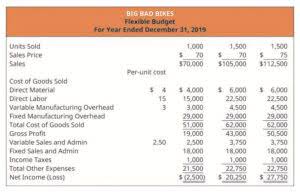
Any costs for amortization, expensing, write-off, or write-down of goodwill (however represented) are unallowable. From the perspective of investors and creditors, the cost principle provides a measure of accountability and transparency for the company’s financial performance. By recording assets at their original purchase price, investors and creditors can assess the company’s financial position and profitability with greater accuracy. Furthermore, this principle can help prevent companies from overvaluing their assets and inflating their financial statements, which can lead to fraudulent practices and financial instability. The cost principle, also known as the historical cost principle, is an accounting convention that has been used for centuries to Insurance Accounting determine the value of assets and liabilities. The principle states that an asset should be recorded at the price paid to acquire it, and that a liability should be recorded at the amount owed to settle it.

Asset values are objective and can be easily verified.
- Moreover, fair value adjustments can introduce volatility into financial statements, making it harder for stakeholders to assess long-term trends and stability.
- It usually performs management, supervisory, or administrative functions, and may also perform service functions in support of the operations of the various segments.
- Historical cost accounting, as previously mentioned, records assets at their original purchase price.
- For example, companies could be required to provide additional disclosures about the market value of their assets.
- The asset cost or price is then never adjusted for changes in the market or economy and changes due to inflation.
- The essence of the Cost Principle lies in its emphasis on the historical, verifiable cost of assets at the time of acquisition, contributing to the reliability and consistency of financial reporting.
Another exception to the cost principle are accounts receivable. The realizable balance is the balance expected once the accounts are paid on. As such, the net balance for accounts receivable will fluctuate over time, like liquid assets will. Despite its advantages, fair value accounting is not without challenges. Determining the fair value of an asset often involves a degree of estimation and judgment, which can introduce subjectivity into the financial statements. This subjectivity can lead to inconsistencies and potential manipulation, as different accountants might arrive at different valuations for the same asset.
Definition and Explanation of Cost Principle
Both benefits and drawbacks of the cost principle are explained below. In this example, goodwill must be tested annually for impairment. If it is worth less than the value on the books, then the goodwill is considered to be impaired. If it has risen in value, then no changes are cost principle made to the historical cost. This is an example of how cost principle can be detrimental in terms of asset appreciation. It is also an example of how it is advantageous when it comes to depreciation.
100 Scope of subpart.
- This principle is used in both IFRS (the Principle Base) and US GAAP ( Rule Base).
- Yes, when using the cost principle, depreciation of an asset still needs to be recorded.
- The overall objective is to provide that, to the extent practicable, all organizations of similar types doing similar work will follow the same cost principles and procedures.
- In conclusion, the future of the Cost Principle in accounting is uncertain.
- Asset impairment indicates that an asset’s fair market value has dropped below what it was originally listed as.
The cost principle, also known as the historical cost principle, is a commonly payroll used accounting method. It focuses on keeping balance sheets consistent over time, and assigns a constant value to assets. Other methods that can be used are the fair market value, as well as the asset impairment method. Liquid assets, like debt or equity investments, are exempt from the cost principle. They aren’t used for any other purpose, like machinery or equipment is.
104 Contracts with educational institutions.
- However, application of cost principles to fixed-price contracts and subcontracts shall not be construed as a requirement to negotiate agreements on individual elements of cost in arriving at agreement on the total price.
- It has provided a consistent framework for companies to report their financials, and it has helped to ensure that financial statements are reliable.
- The Cost Principle is a crucial accounting convention that ensures businesses record their assets at the cost incurred during their acquisition.
- These financial relationships support our content but do not dictate our recommendations.
The Cost Principle is an essential accounting concept that helps to ensure that financial statements are accurate, reliable, and consistent over time. By recording assets at their original cost, the Cost Principle promotes objectivity in financial reporting and helps to avoid distortions caused by changes in the market. While there are exceptions to the rule, the Cost Principle is a fundamental concept that is used in many different areas of accounting.

The principle also applies in cases where companies purchase inventory, as it allows them to record the cost of goods sold accurately. The historical cost principle states that a company or business must account for and record all assets at the original cost or purchase price on their balance sheet. No adjustments are made to reflect fluctuations in the market or changes resulting from inflationary fluctuations. The historical cost principle forms the foundation for an ongoing trade-off between usefulness and reliability of an asset.

It does not require updating from period to period.
Initial outfitting of the unit is completed when the unit is ready and available for normal operations. Funded pension cost means the portion of pension cost for a current or prior cost accounting period that has been paid to a funding agency. Defined-benefit pension plan means a pension plan in which the benefits to be paid, or the basis for determining such benefits, are established in advance and the contributions are intended to provide the stated benefits. Cost input means the cost, except general and administrative (G&A) expenses, which for contract costing purposes is allocable to the production of goods and services during a cost accounting period. Actual costs means (except for subpart 31.6) amounts determined on the basis of costs incurred, as distinguished from forecasted costs.

For example, in industries where there is rapid technological change, the Cost Principle may not accurately reflect a company’s true value. This is because the market value of a company’s assets may be higher than their book value. In these cases, investors may be more interested in a company’s market value than its book value.
As an illustration of how the cost principle works, consider a small manufacturer that purchased a packing machine for $100,000 in 2018. The asset is added to the company’s balance sheet with a value of $100,000. For example, if a company owns a piece of land that has significantly increased in value since it was purchased, the cost principle would require it to be recorded at its original cost. However, this may not accurately reflect its true value to the company, particularly if the land is sold at a later date. Cost Principle states that an asset should always be recorded at the original buying price or cost and not the perceived value. Therefore, any changes in the asset’s market value should not affect how they are represented on the balance sheet.
